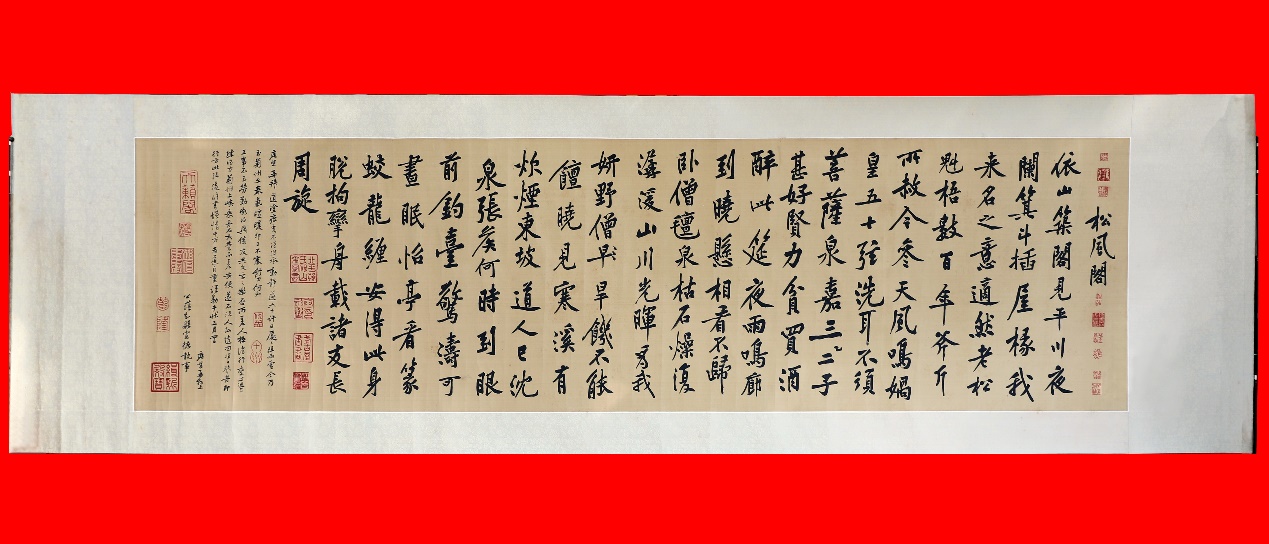
2020年6月1日,我处征集到天津市孙女士的一件(黄庭坚《松风阁》),经双方友好协商特向广大收藏投资爱好者朋友公布以下信息!
On June 1, 2020, we collected a piece from ms sun of Tianjin city 《Huang tingjian's (song feng ge)》. through friendly negotiation, we hereby announce the following information to friends of collectors and investors.
黄庭坚,字鲁直,号山谷道人,晚号涪翁,洪州分宁(今江西修水县)人,北宋著名文学家、书法家,为盛极一时的江西诗派开山之祖,与杜甫、陈师道和陈与义素有“一祖三宗”(黄庭坚为其中一宗)之称。与张耒、晁补之、秦观都游学于苏轼门下,合称为“苏门四学士”。生前与苏轼齐名,世称“苏黄”。著有《山谷词》,且黄庭坚书法亦能独树一格,与苏轼、米芾、蔡襄等被称为宋四家。
Huang Tingjian, a famous writer and calligrapher of the Northern Song Dynasty, was the founder of Jiangxi poetry school at its peak and was known as "one ancestor and three ancestors" (Huang Tingjian was one of them) with Du Fu, Chen Shidao and Chen Yuyi. Together with Zhang Lei, Chao Buzhi and Qin Guan, they all studied under Su Shi and are collectively called "Four Bachelor of Su". During his lifetime, he was as famous as Su Shi and was known as "Su Huang" in the world. He wrote "Valley Ci" and Huang Tingjian's calligraphy is unique. He is called Song Sijia with Su Shi, Mi Fei and Cai Xiang.

黄庭坚为盛极一时的江西诗派开山之祖。江西修水县人。北宋诗人,书法家,词人,英宗治平四年(1067年)进士。历官叶县尉、北京国子监教授、校书郎、著作佐郎、秘书丞、涪州别驾、黔州安置等。哲宗立,召为校书郎、《神宗实录》 检讨官。后擢起居舍人。绍圣初,新党谓其修史“多诬”,贬涪州别驾,安置黔州等地。徽宗初,羁管宜州卒。宋英宗治平四年进士,绍圣初以校书郎坐修《神宗实录》失实被贬职,后来新党执政,屡遭贬。
Huang tingjian was the founder of Jiangxi poetry school. People from xiushui county, Jiangxi Province. Northern Song Dynasty poet, calligrapher, poet, Yingzong Zhiping four years (1067) Jinshi. Li Guan Ye County commandant, Beijing professor imperial academy, school calligrapher, book writer Zuolang, secretary Cheng, Fu Zhou Biejia, Qian Zhou resettlement, etc. Zhe zongli was called as a school calligrapher and a reviewer of the record of god zong. After the promotion of living roommates. At the beginning of Shaosheng, the new party called its history revision "more false", demoted Fuchou to quit driving and settled in Qianzhou and other places. At the beginning of Huizhou, he was in charge of Yizhou's soldiers. Song Yingzong had been a successful candidate in the highest imperial examination for four years. Shao Shengchu was demoted to the position of a school calligrapher in the book Record of the Emperor. Later, the new party came into power and was demoted repeatedly.
黄庭坚书法初以宋代周越为师,后来受到颜真卿、怀素、杨凝式等人的影响,又受到焦山《瘗鹤铭》书体的启发,行草书形成自己的风格。黄庭坚大字行书凝练有力,结构奇特,几乎每一字都有一些夸张的长画,并尽力送出,形成中宫紧收、四缘发散的崭新结字方法,对后世产生黄庭坚很大影响。在结构上明显受到怀素的影响,但行笔曲折顿挫,则与怀素节奏完全不同。在他以前,圆转、流畅是草书的基调,而黄庭坚的草书单字结构奇险,章法富有创造性,经常运用移位的方法打破单字之间的界限,使线条形成新的组合,节奏变化强烈,因此具有特殊的魅力,成为北宋书坛杰出的代表,与苏轼成为一代书风的开拓者。后人所谓宋代书法尚意,就是针对他们在运笔、结构等方面更变古法,追求书法的意境、情趣而言的。
《松风阁诗帖》是黄庭坚七言诗作并行书,墨迹纸本,全文计29行,153字。台北故宫博物院藏。
松风阁在湖北省鄂州市之西的西山灵泉寺附近,海拔160多米,古称樊山,是当年孙权讲武修文、宴饮祭天的地方。宋徽宗崇宁元年(1102)九月,黄庭坚与朋友游鄂城樊山,途经松林间一座亭阁,在此过夜,听松涛而成韵。“松风阁诗”,歌咏当时所看到的景物,并表达对朋友的怀念。《松风阁诗帖》是黄庭坚晚年作品,黄庭坚一生创作了数以千百的行书精品,其中最负盛名者当推《松风阁诗帖》。其风神洒荡,长波大撇,提顿起伏,一波三折,意韵十足,不减遒逸《兰亭》,直逼颜氏《祭侄》,堪称行书之精品。
(Song Feng Ge) Shi Tie is a running script of Huang Tingjian's seven-character poems, written in ink and paper, with 29 lines and 153 words. Taipei palace museum collection.
Songfeng Pavilion is located near Lingquan Temple in Xishan, west of Ezhou City, Hubei Province. It is more than 160 meters above sea level and is called Fanshan in ancient times. It was the place where Sun Quan lectured on martial arts and held feasts to worship heaven. In September (1102) of the first year of Chongning in Song Huizong, Huang Tingjian and his friends traveled to Fanshan in the city of Hubei, passing through a pavilion in the pine forest. They stayed overnight and listened to the song tao to form a rhyme. "Song Feng Ge Shi" sings the scenery seen at that time and expresses the memory of friends. Song Feng Ge Shi Tie is the work of Huang Tingjian in his later years. Huang Tingjian has created thousands of excellent running scripts in his whole life, of which the most famous one is Song Feng Ge Shi Tie. It is full of charm, long waves and ups and downs, and Teton is full of twists and turns. It does not lose its charm of Lanting, which is comparable to Yan's Sacrifice to Nephew. It can be called a masterpiece of running script.

依山筑阁见平川,夜阑箕斗插屋椽。
我来名之意适然。
老松魁梧数百年,斧斤所赦今参天。
风鸣娲皇五十弦,洗耳不须菩萨泉。
嘉三二子甚好贤,力贫买酒醉此筵。
夜雨鸣廊到晓悬,相看不归卧僧毡。
泉枯石燥复潺湲,山川光辉为我妍。
野僧旱饥不能饘,晓见寒溪有炊烟。
东坡道人已沈泉,张侯何时到眼前。
钓台惊涛可昼眠,怡亭看篆蛟龙缠。
安得此身脱拘挛,舟载诸友长周旋。
《松风阁诗帖》经宋、元、明、清辗转流传,宋朝为向民收藏,后归贾似道,又迭经明顶元汴、清安岐,而入清内府。
清道光年间此帖曾到鄂籍王家璧(孝凤)手中。
王家璧于道光二十四年(1844年)中进士,授兵部主事,任顺天(河北)乡试誊录官、会试受卷官之职,乘任职之便,有心搜集到鄂州之故物黄庭坚《松风阁诗卷》和宋代蔡襄墨迹等传世文物,携带回鄂。
道光举人柯茂枝题《黄山谷松风阁诗卷并序》序曰:“王孝凤武部得此卷于柳君吕臣,盖元时长公主家故物,上有名贤十数人诗跋,又常为携李天籁阁所藏,项子京卞令之私印尤多,询希之珍也。尾不署涪翁(山谷)名字,纸色、绢色尚觉鲜好,然神采奕奕,尚非翻身凤凰。
武昌(鄂州)传涪翁以松风阁一诗,然阁不时废,诗为世共独,此一墨宝,历数朝后复入吾邑士大夫手,山川笔墨之缘岂偶然哉。爱玩之久,为次原韵以赋其事,时咸丰九年(1859年)春三月。”
此件藏品此套书画是九九年启功老师带领专家团队由北京故宫博物院,台北故宫博物舘,辽宁博物館调出的字画真迹复制。
金絲南木是当年天安门城楼的一个木柱坏了換下来的由专家团队出资买来作了一部分木盒。
此藏品为翰墨絲绸板属国宝级。有鉴定证书以及收藏证书为证。
This collection, this set of calligraphy and painting, was copied by the expert team led by Professor Qigong in 1999 from Beijing Palace Museum, Taipei Palace Museum and Liaoning Museum.
Jin Si Nan Mu was bought as part of a wooden box by an expert team after a wooden pillar on Tiananmen Gate broke down.
This collection is a calligraphy silk board, which is a national treasure. There is an authentication certificate and a collection certificate to prove it.


价格可商议!若有缘人看到此推送,对此件藏品感兴趣有意收藏投资,请后台留言联系我处,将竭诚为您服务!
The price is negotiable! If you are interested in collecting and investing in this collection, please contact us in the background and we will serve you wholeheartedly!

